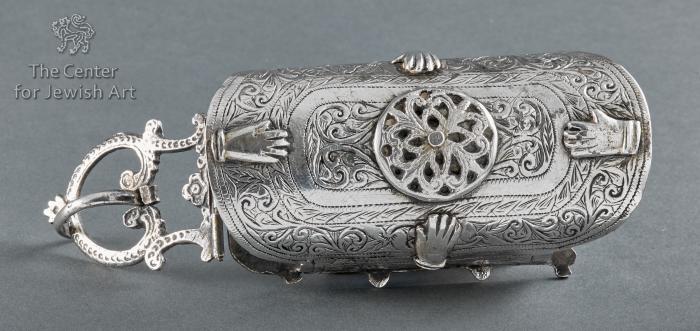Obj. ID: 36696 Belt Buckle, Essaouira (Mogador), circa 1935

sub-set tree:
Name/Title
Belt Buckle | Unknown
Object
Object Detail
Date
circa 1935
Synagogue active dates
Reconstruction dates
Artist/ Maker
Unknown (Unknown)
Origin
Historical Origin
Unknown
Community
Location
Unknown |
Site
Unknown
School/Style
Unknown|
Period
Period Detail
Gross Family Collection No.
043.001.006
Category
Material/Technique
Silver, Engraved, Cast, Soldered
Material Stucture
Material Decoration
Material Bonding
Material Inscription
Material Additions
Material Cloth
Material Lining
Tesserae Arrangement
Density
Colors
Construction material
Measurements
Height: 5.8 cm, Length: 16.4 cm, Depth: 3.5 cm
Height
Length
Width
Depth
Circumference
Thickness
Diameter
Weight
Axis
Panel Measurements
Hallmark
CITY - Ram's Head with M - Essaouira
Iconographical Subject
Condition
Extant
Documented by CJA
Surveyed by CJA
Present Usage
Present Usage Details
Condition of Building Fabric
Architectural Significance type
Historical significance: Event/Period
Historical significance: Collective Memory/Folklore
Historical significance: Person
Architectural Significance: Style
Architectural Significance: Artistic Decoration
Urban significance
Significance Rating
Description
The following description was prepared by William Gross:
This is a typical belt buckle from this period in Morocco, decorated with the hamsa. Such a form of the buckle is called "fekroun". This example is marked on the back with silver marks identifying the city of origin as Essaouira. The hamsot give protection to the wearer. Almost all the silversmiths in this city were Jews.
The hamsa (five, as in five fingers) is an amulet shaped like a hand. The hamsa is arguably the most popular form of amulet against the Evil Eye and is used in a large number of countries. Probably originating in Moslem Spain of the 12th or 13th century, it crossed the sea to Morocco and spread across North Africa to the Middle and the Far East.
Custom
Contents
Codicology
Scribes
Script
Number of Lines
Ruling
Pricking
Quires
Catchwords
Hebrew Numeration
Blank Leaves
Direction/Location
Façade (main)
Endivances
Location of Torah Ark
Location of Apse
Location of Niche
Location of Reader's Desk
Location of Platform
Temp: Architecture Axis
Arrangement of Seats
Location of Women's Section
Direction Prayer
Direction Toward Jerusalem
Signature
Colophon
Scribal Notes
Watermark
Binding
Decoration Program
Summary and Remarks
History/Provenance
Main Surveys & Excavations
Bibliography
Short Name
Full Name
Volume
Page
Type
Documenter
|
Researcher
|
Architectural Drawings
|
Computer Reconsdivuction
|
Section Head
|
Language Editor
|
Donor
|
Object Copyright
Gross Family Collection (GFC)




